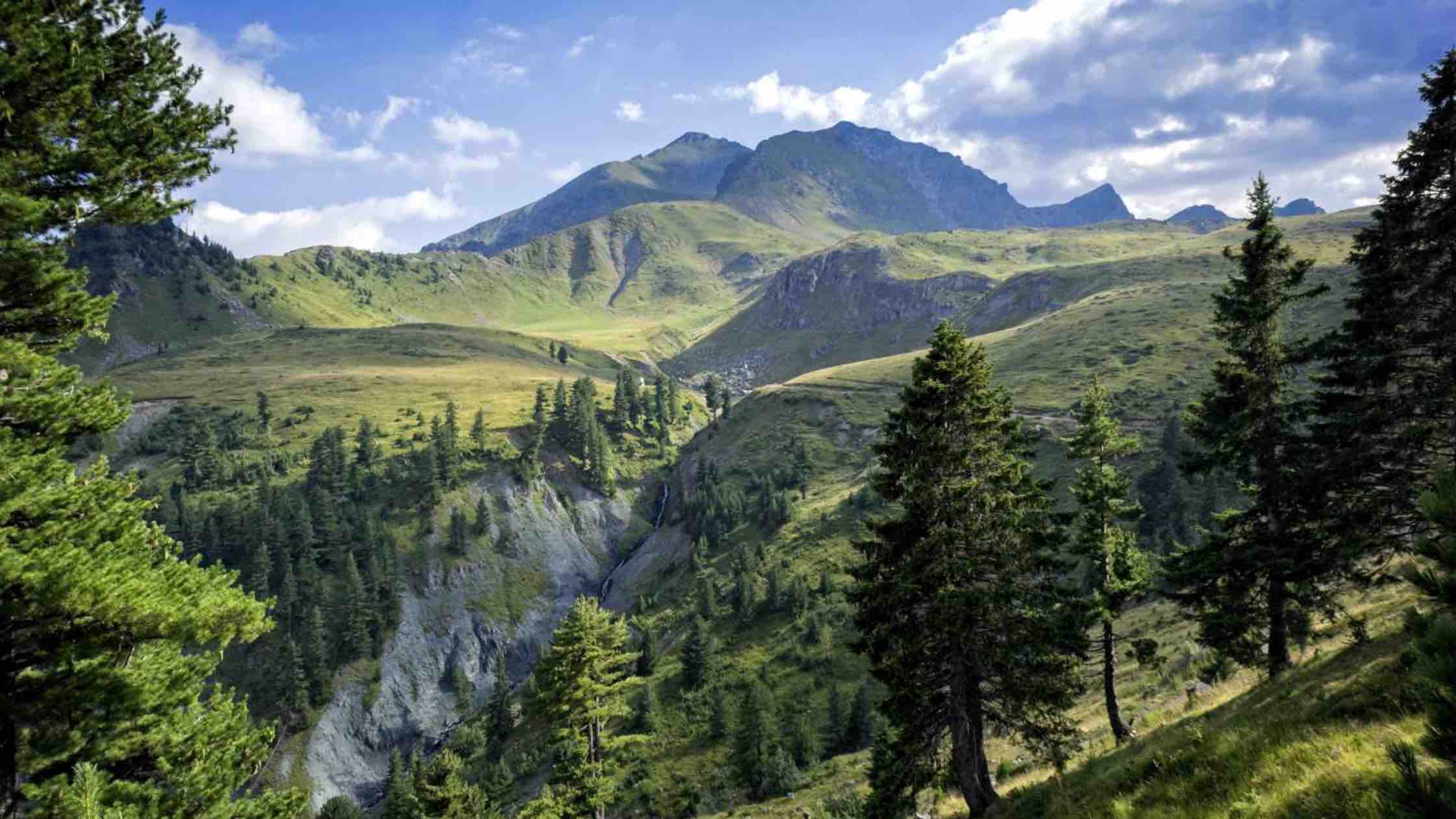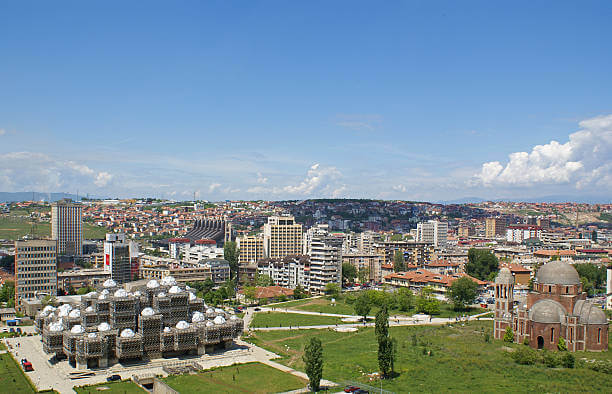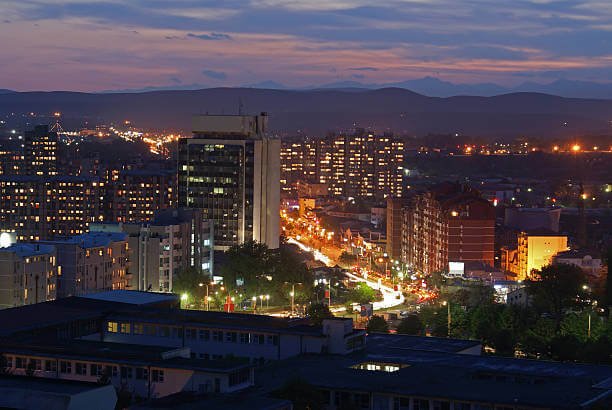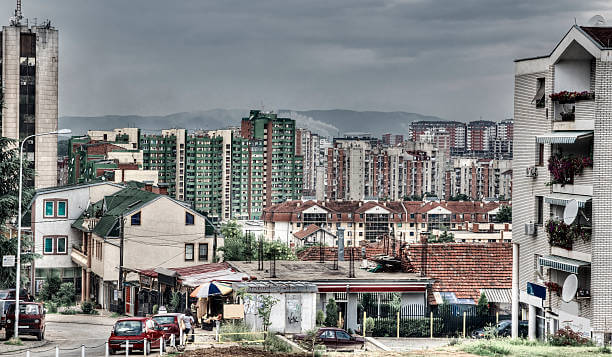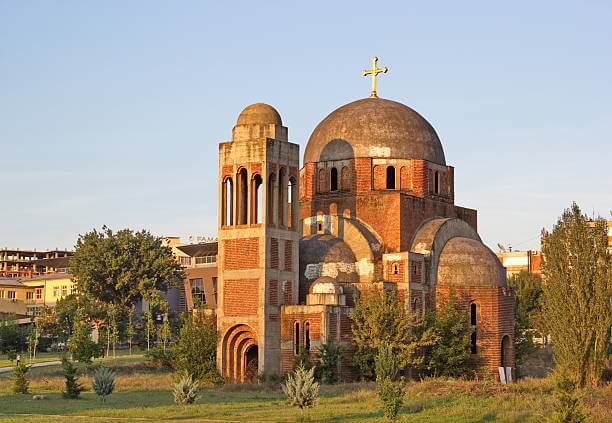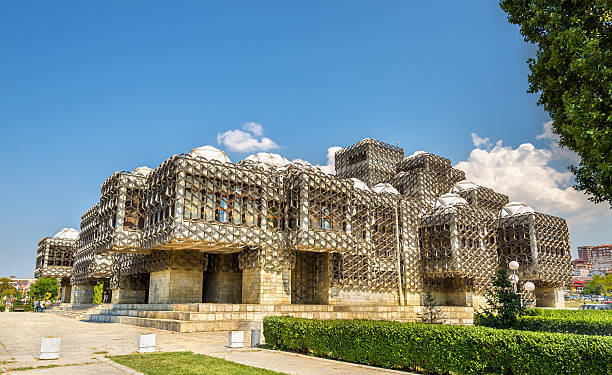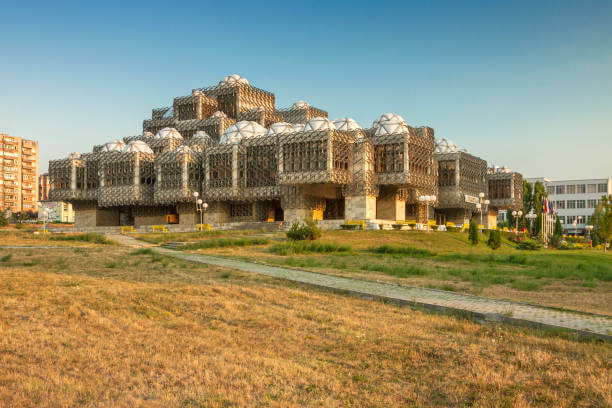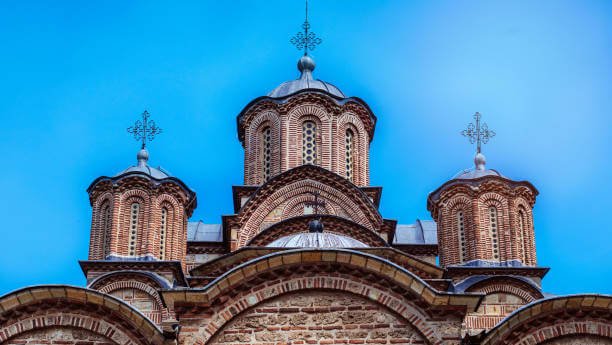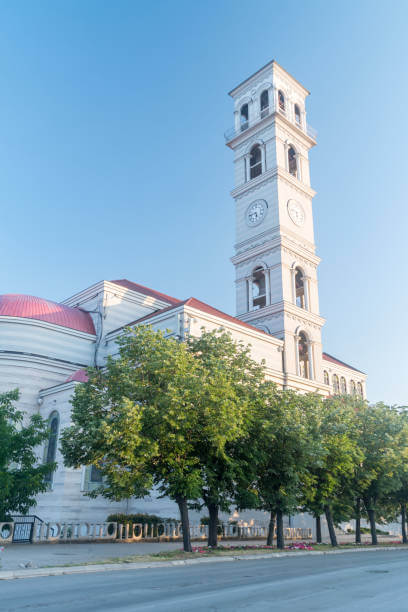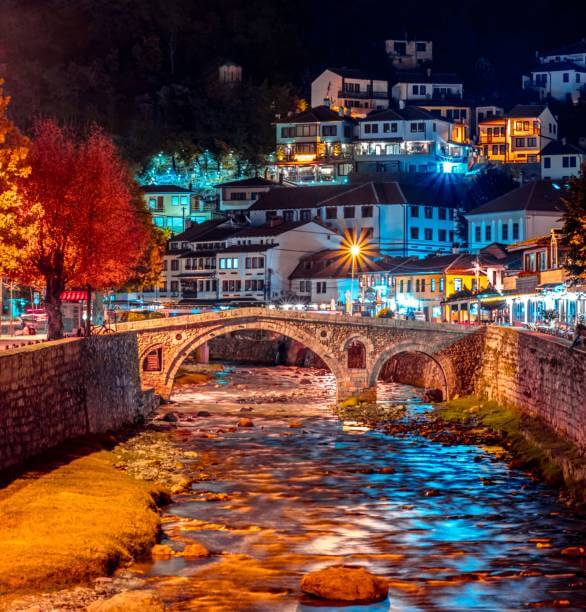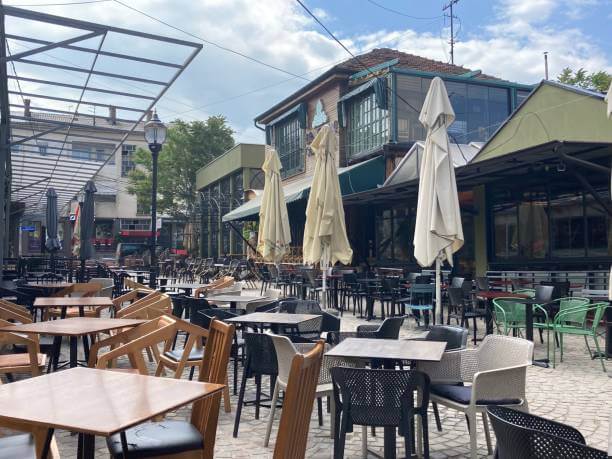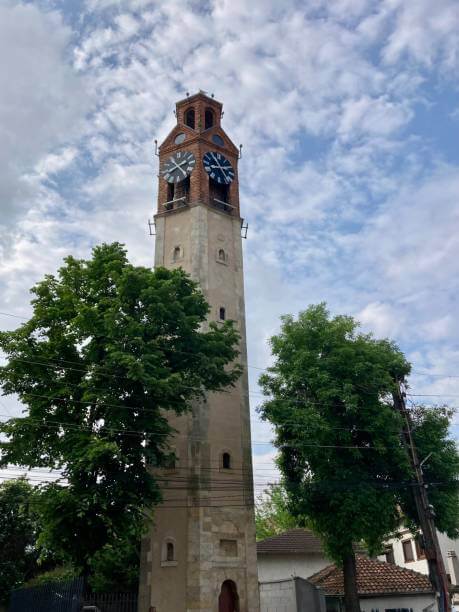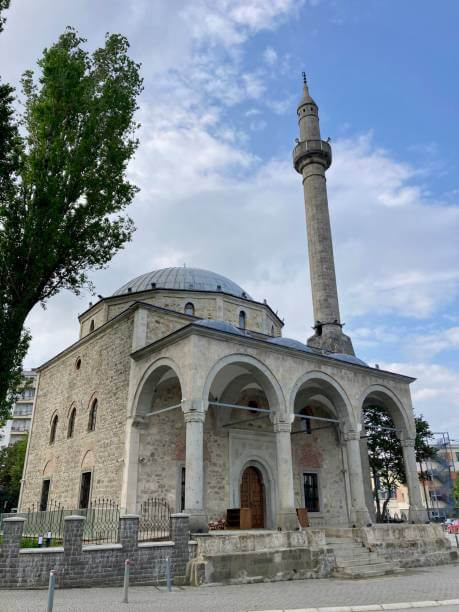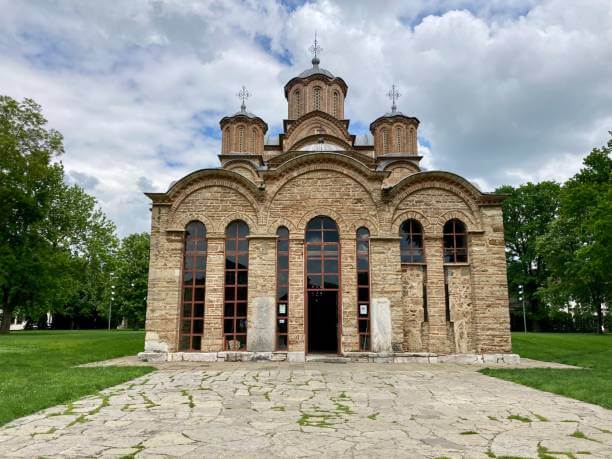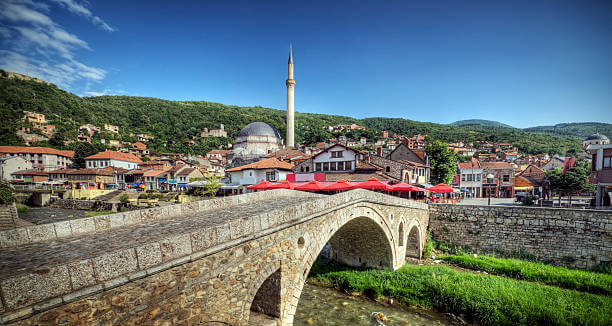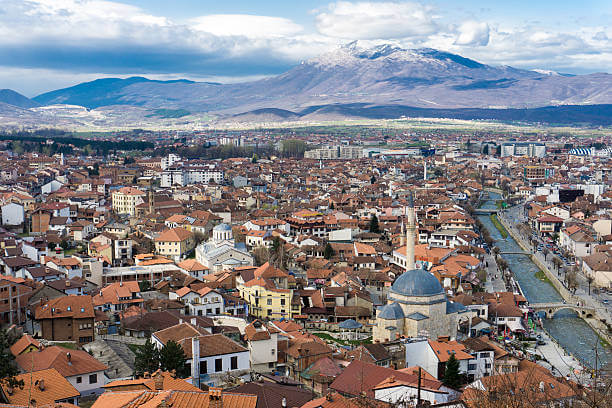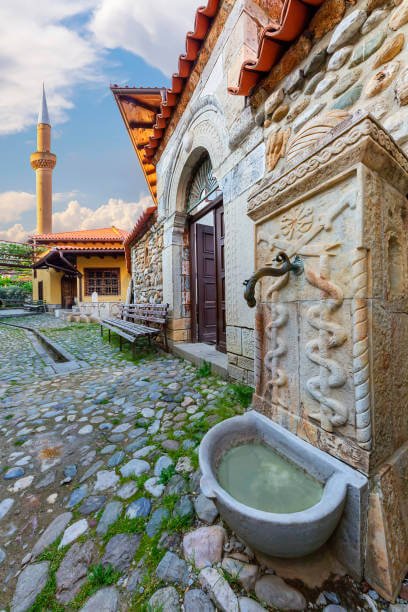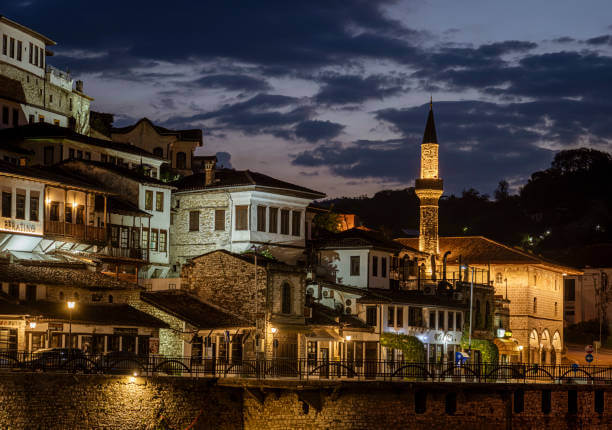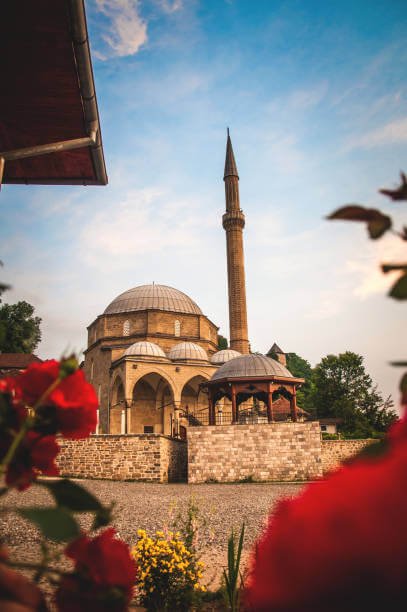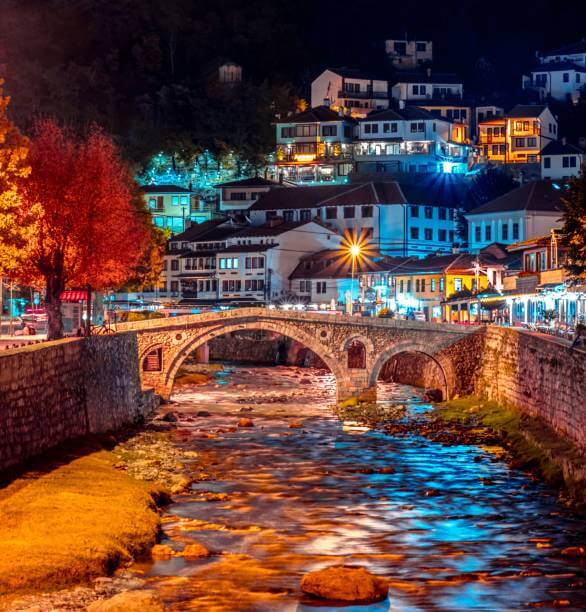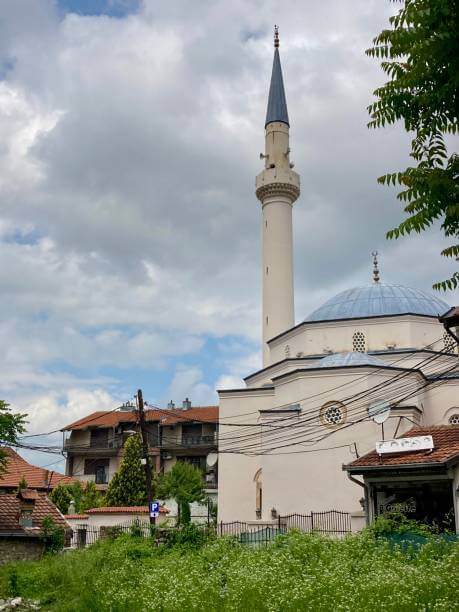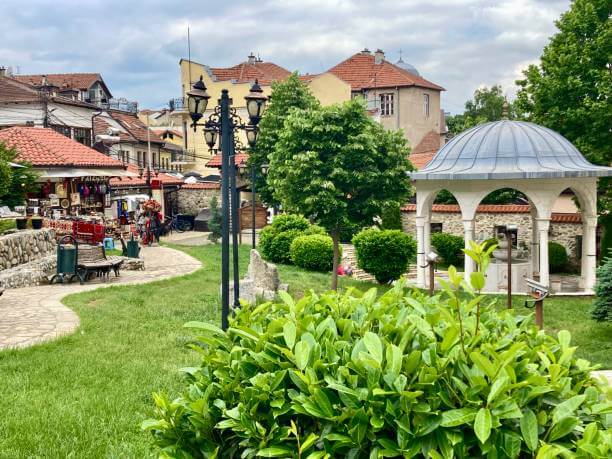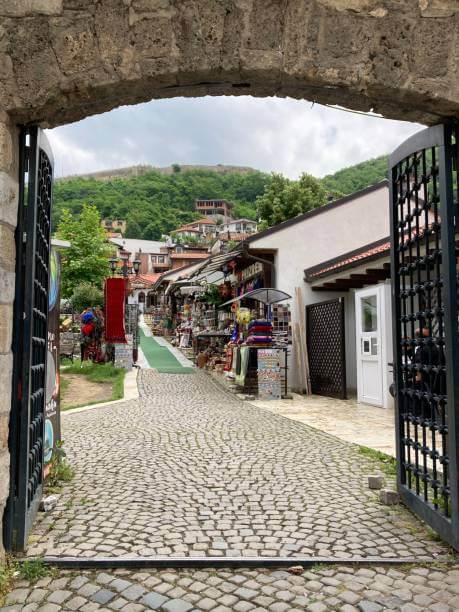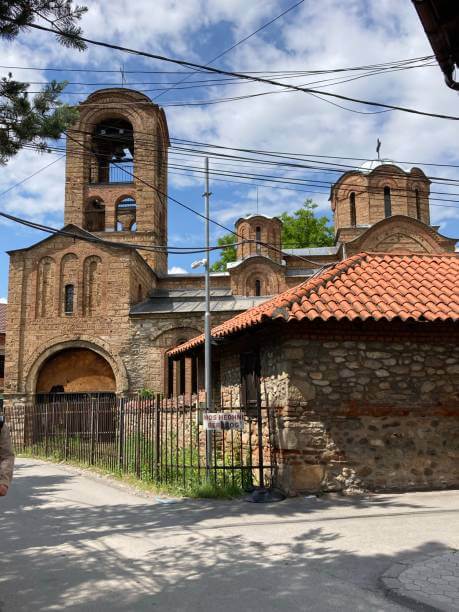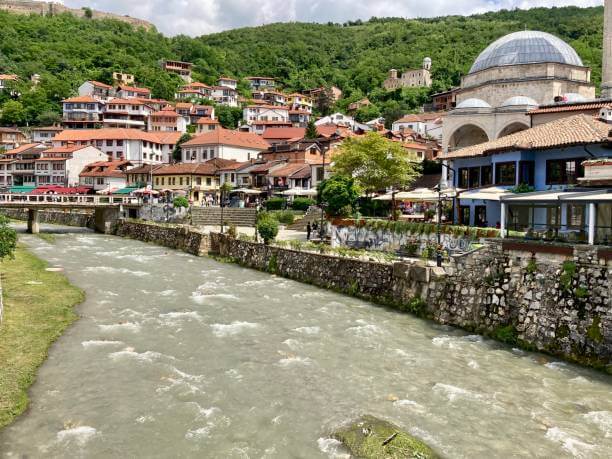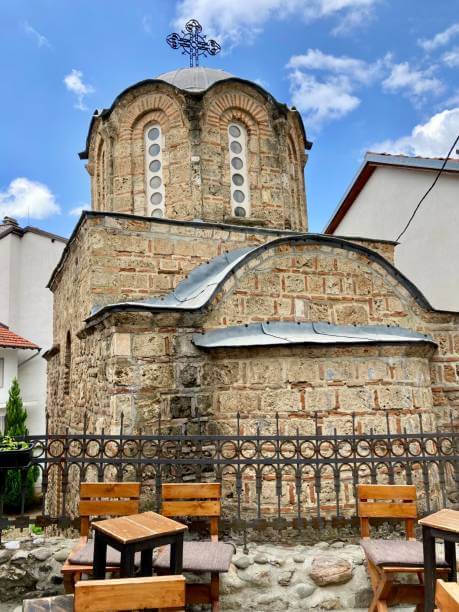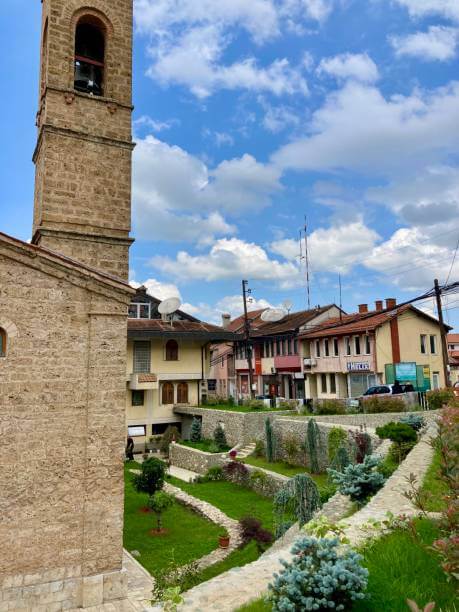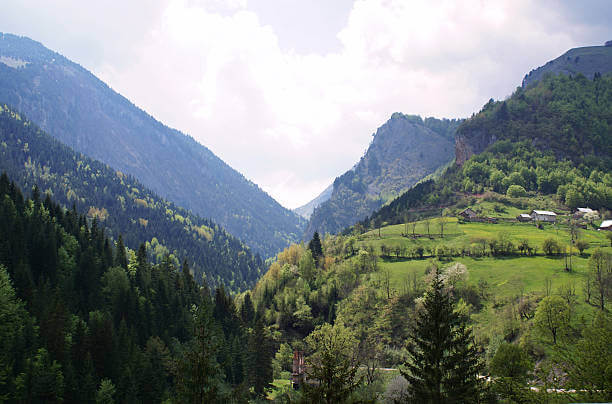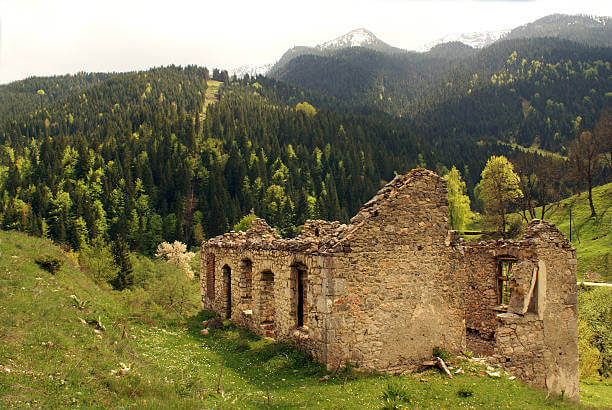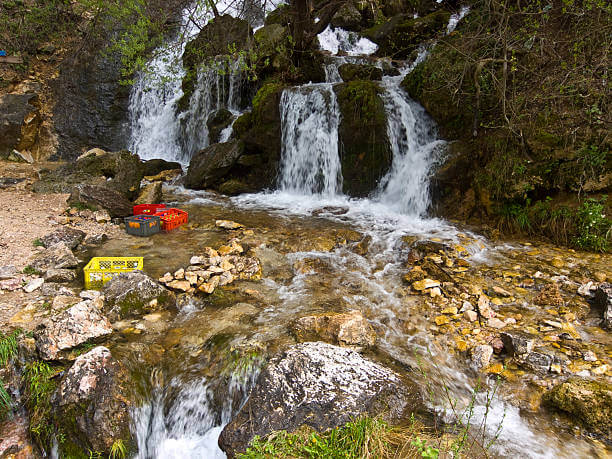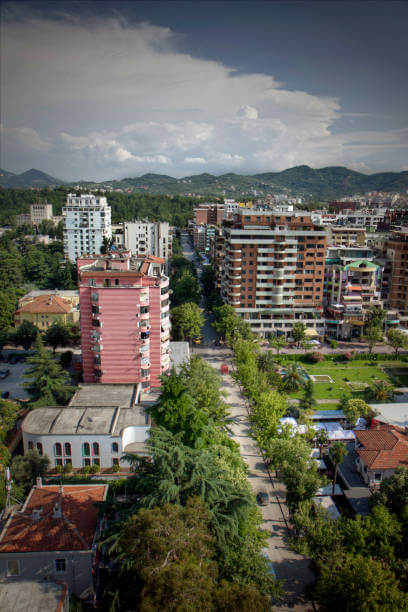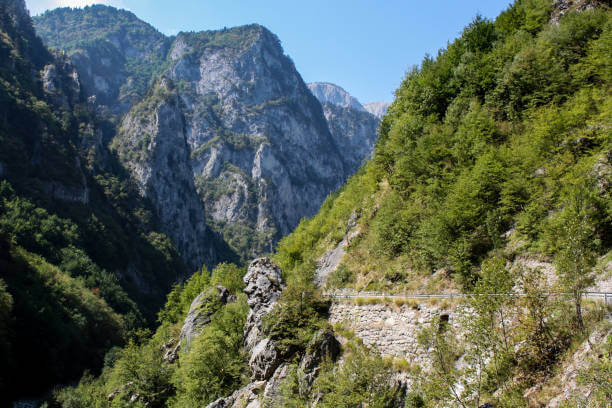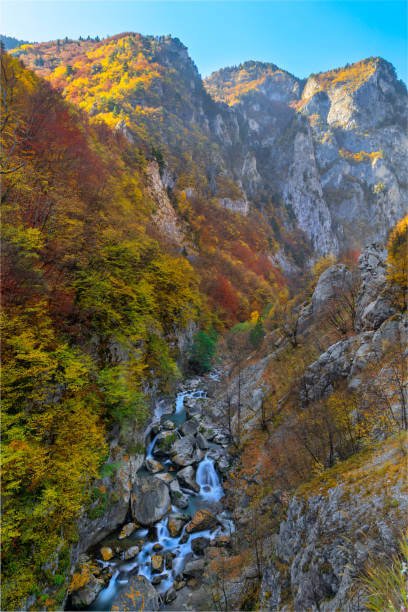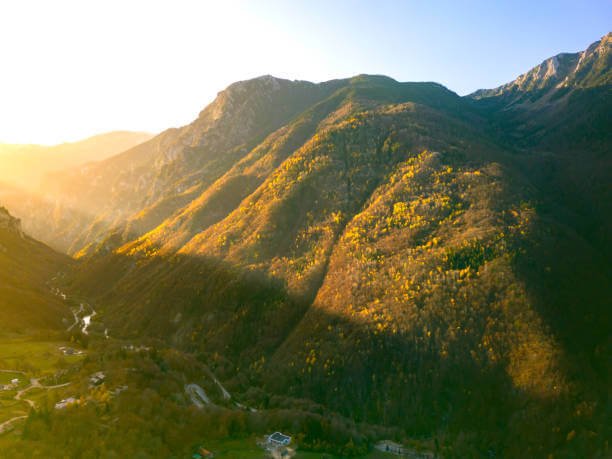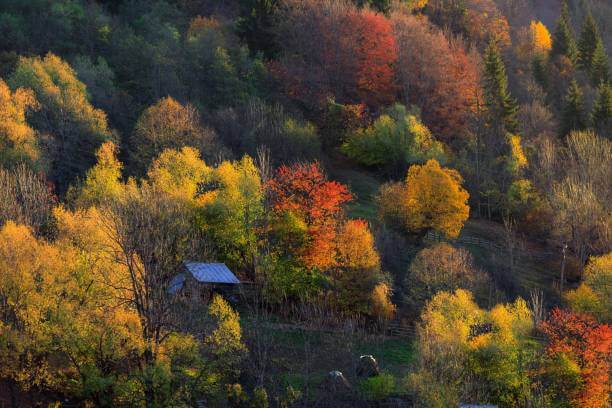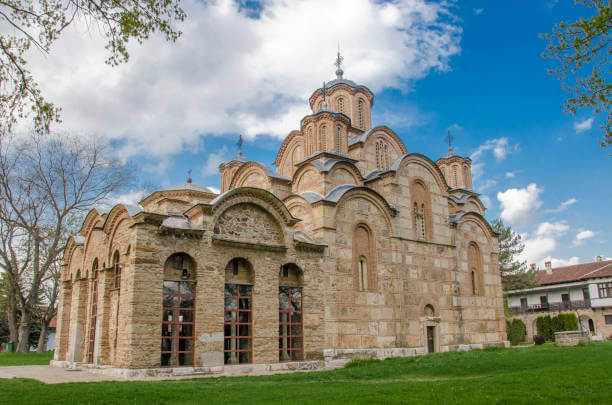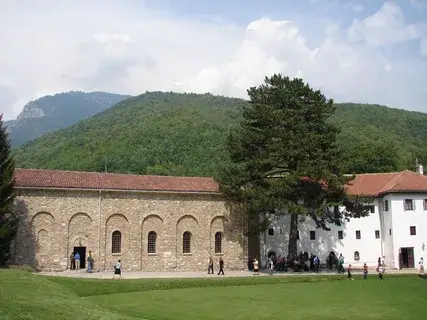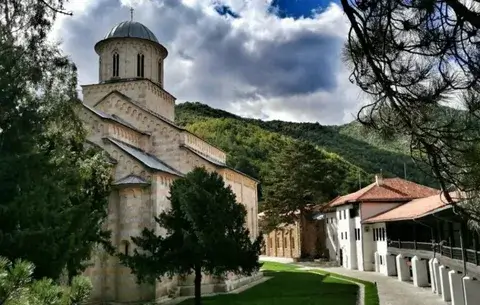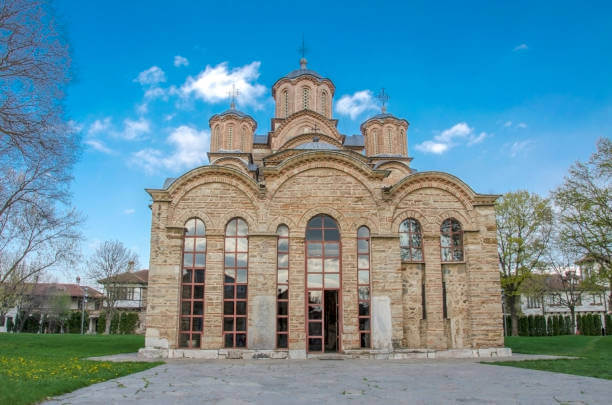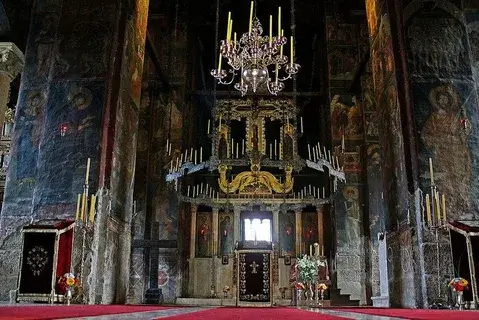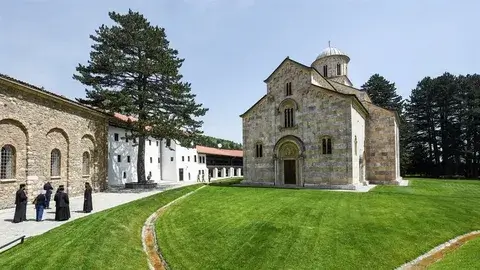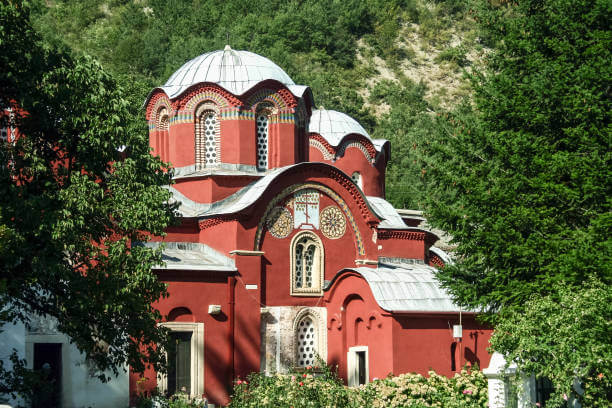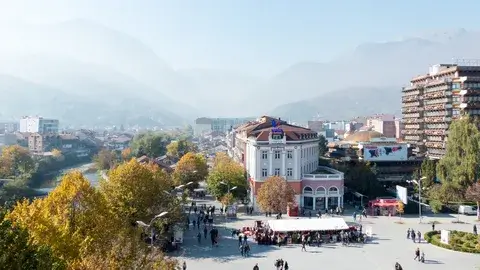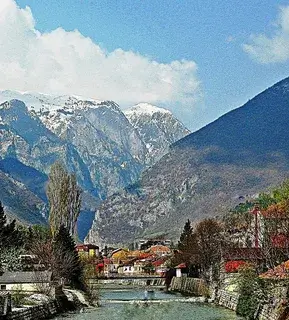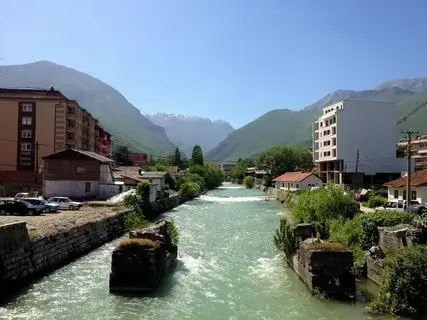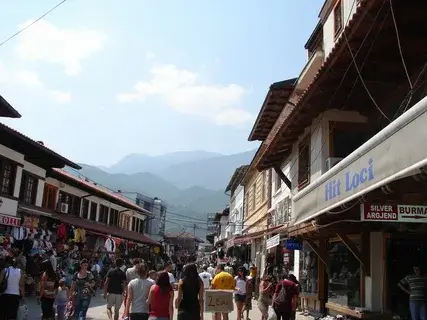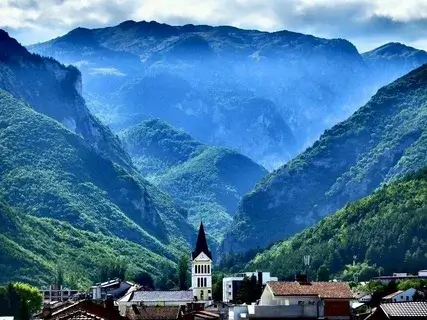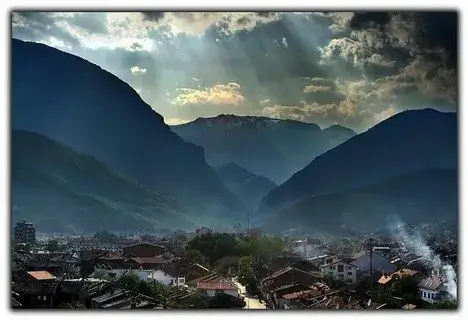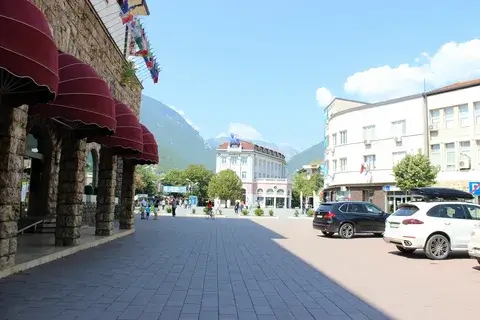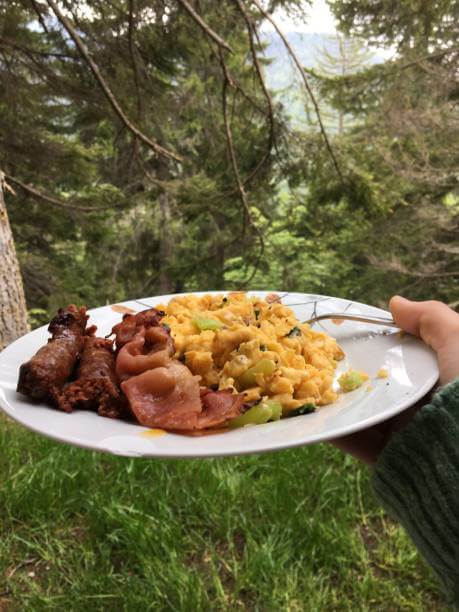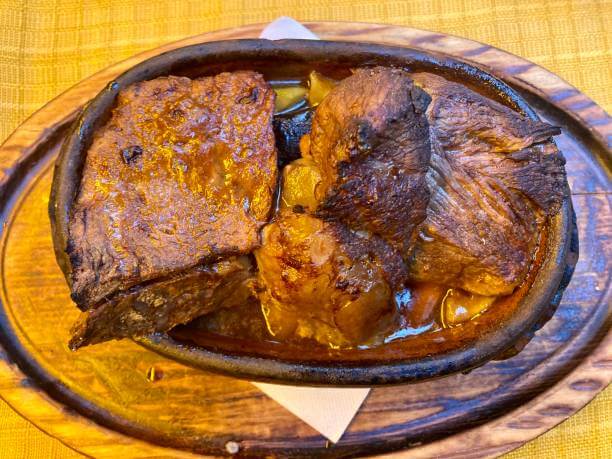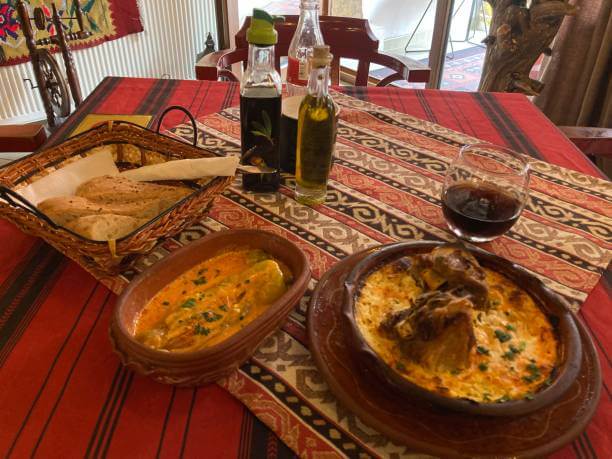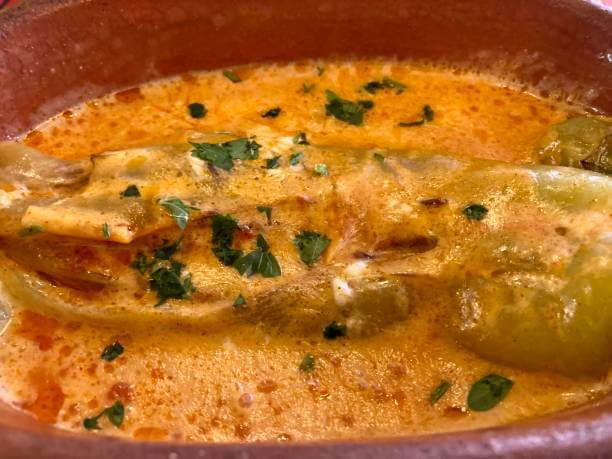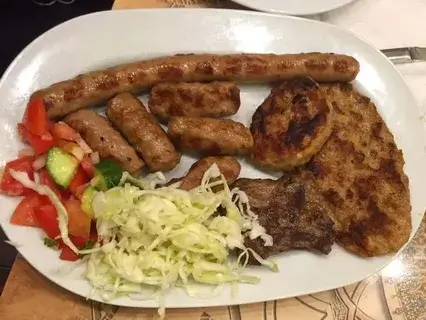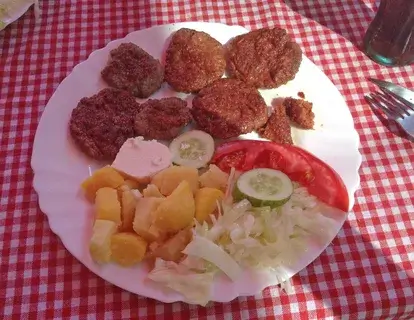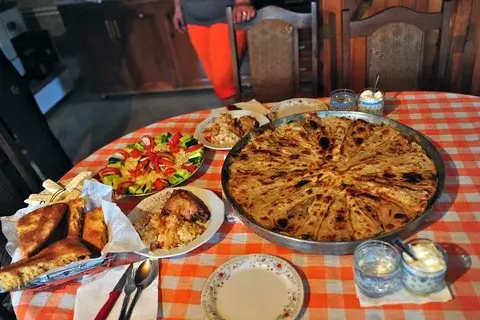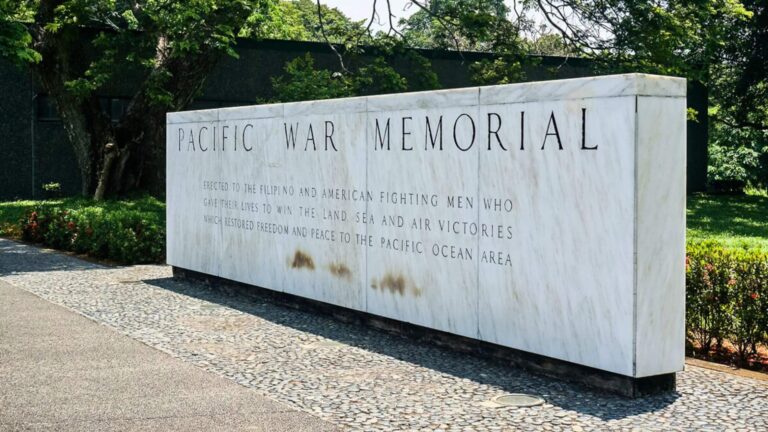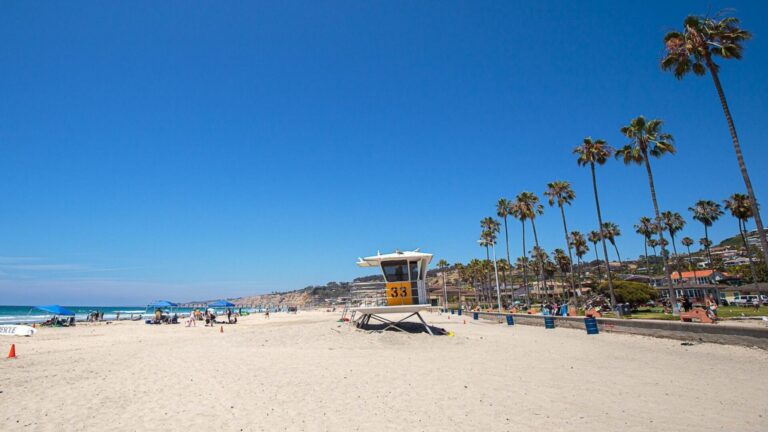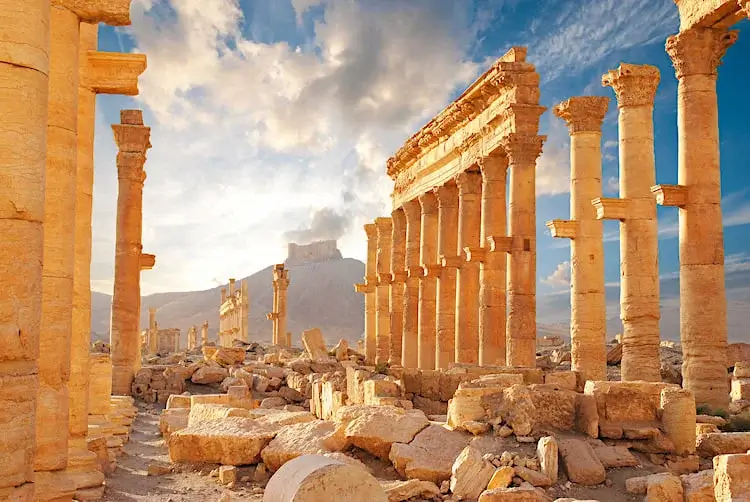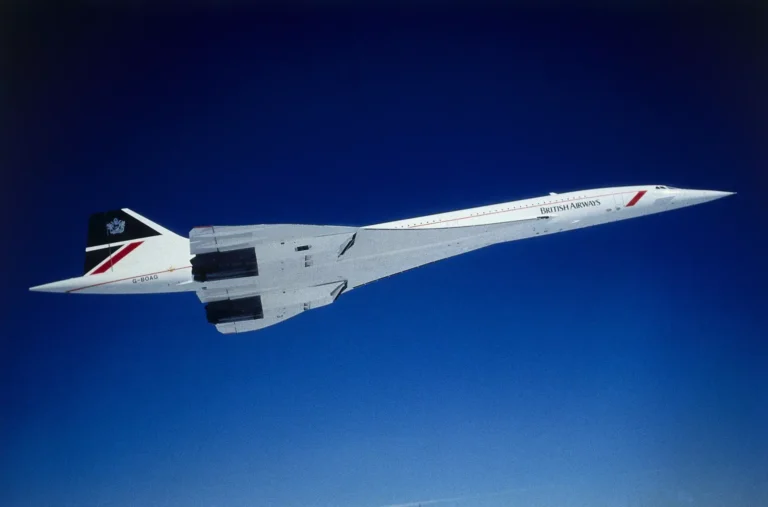Our Top 5 Best Places To Visit In Kosovo
Discovering Kosovo’s Hidden Gems: 5 Must-Visit Places

Welcome to Kosovo, a land of cultural riches and breathtaking landscapes that will leave you in awe. This often-overlooked European destination is brimming with history, vibrant cities, and natural beauty. Join us as we explore the top 5 must-visit places in Kosovo, each offering a unique and unforgettable experience.
Map of Kosovo and Bordering Countries:
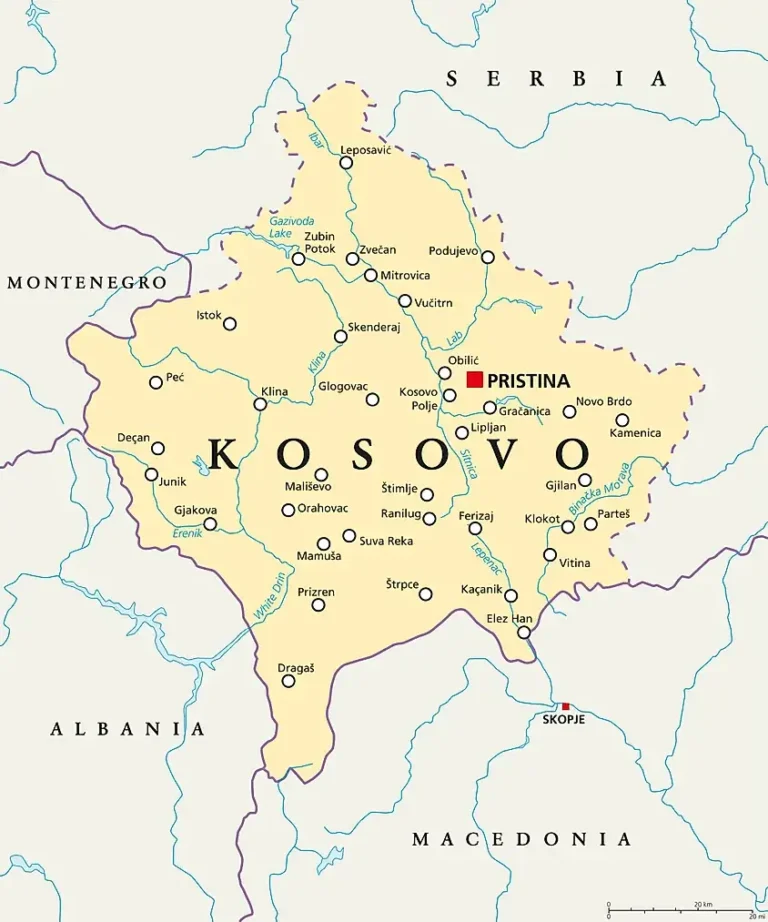
Map Showing Kosovo Location:

Countries Bordering Kosovo:
Kosovo is a self-declared independent country in the Balkans region of Europe. Kosovo is landlocked and bordered by Serbia to the north and east, North Macedonia to the south, Albania to the west, and Montenegro to the northwest. Kosovo, about the same size as Jamaica or Lebanon, is the smallest country in the Balkans.
Our Top 5 Best Places To Visit In Kosovo:
1. Pristina: A Fusion of Tradition and Modernity
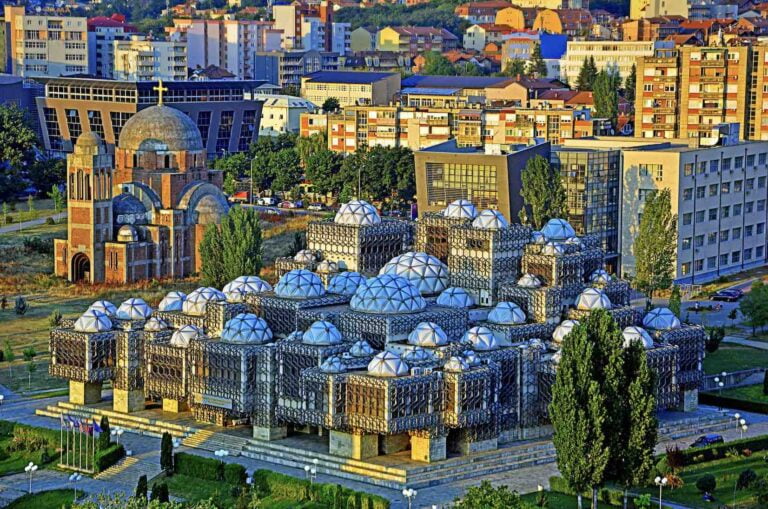

Kick off your journey in the capital city, Pristina. This bustling urban hub is a melting pot of cultures, where ancient history meets contemporary art.
Explore the Newborn Monument, a symbol of Kosovo’s independence, and immerse yourself in the vibrant café culture that lines Mother Teresa Square.
Don’t miss the stunning National Library and the Grand Hamam, remnants of the Ottoman era.
2. Prizren: A Historical Gem
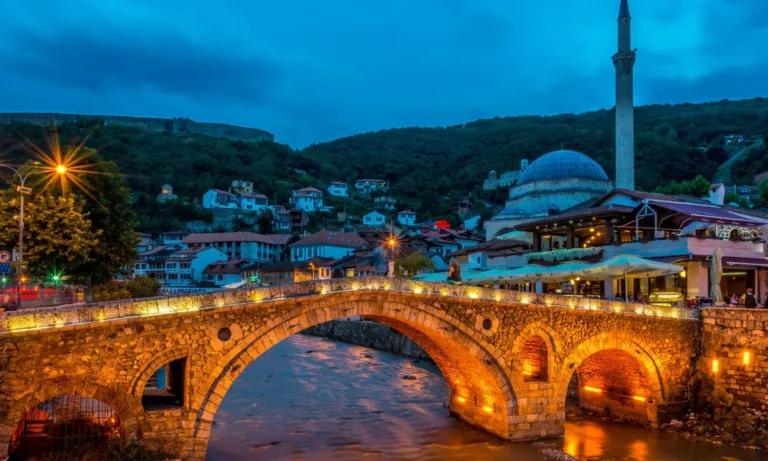

Journey to Prizren, a charming town that embodies the soul of Kosovo. Cobblestone streets wind through its old town, revealing Ottoman architecture and centuries of history.
The Sinan Pasha Mosque, the League of Prizren Complex, and the iconic Old Stone Bridge are just a few of the architectural treasures waiting to be explored.
Indulge in local cuisine along the Bistrica River and visit the fortress for panoramic views of the town.
3. Rugova Valley: Nature’s Paradise


Escape to the Rugova Valley, a haven for outdoor enthusiasts. With its towering peaks, serene lakes, and pristine forests, this region offers endless opportunities for hiking, rock climbing, and enjoying the great outdoors.
In the winter, the valley transforms into a winter wonderland, attracting skiers and snowboarders.
4. Visoki Dečani Monastery: A Spiritual Retreat


Venture to the Visoki Dečani Monastery, a UNESCO World Heritage Site renowned for its stunning architecture and centuries-old frescoes.
This Serbian Orthodox monastery stands as a testament to Kosovo’s rich spiritual heritage and is a must-visit for history and culture enthusiasts.
5. Peja: A Cultural Oasis


Conclude your journey in Peja, a town known for its spiritual significance and natural beauty.
Explore the Peja Patriarchate, a serene Serbian Orthodox complex with striking architecture and religious history. Discover the vibrant bazaar, where traditional handicrafts and local treats await.
Don’t miss the nearby natural wonders, including the Rugova Gorge and the stunning Waterfall of White Drin.
Did we mention the food? EAT!

Culinary Revelations in Kosovo: A Gastronomic Odyssey
Prepare to embark on a gastronomic journey through the flavors of Kosovo, where traditions are savored with every bite. Kosovo’s cuisine is a fusion of influences from the Mediterranean, Balkans, and Ottoman Empire, resulting in a delightful array of dishes that tell the story of the region’s history.
Indulge in the warmth of “Flija,” a layered pastry cooked over an open fire, symbolizing the community spirit of sharing. Savor the rich flavors of “Pite,” a savory pie filled with meats, cheeses, or vegetables, embodying the heartiness of Kosovar fare.
Delight in “Kosovska Sogan-dolma,” a delicacy of stuffed onions that reflects the Ottoman influence. And no culinary adventure in Kosovo is complete without relishing a cup of strong “Turkish-style” coffee, sipped leisurely in a traditional café. As you partake in these culinary delights, you’re not just tasting the food – you’re immersing yourself in the vibrant tapestry of Kosovo’s culture, history, and warm hospitality.

Essential Things to Know Before Traveling to Kosovo:
Traveling to Kosovo, a captivating destination in the heart of the Balkans, requires careful preparation and awareness of the local customs, culture, and practicalities. Here are essential things to know before your journey:
1. Visa Requirements:
Check the visa requirements for your nationality before traveling to Kosovo. Depending on your passport, you might be able to enter Kosovo without a visa for short stays. Confirm the latest visa regulations before your trip.
2. Safety and Security:
Kosovo is generally safe for travelers, but it’s advisable to stay informed about the current security situation. Follow travel advisories from your government and respect local laws and customs.
3. Language:
The official languages are Albanian and Serbian. English is commonly spoken in urban areas and tourist destinations, making communication relatively easy for travelers.
4. Currency:
The official currency in Kosovo is the Euro (EUR). ATMs are widely available in cities and towns, but it’s recommended to carry some cash for smaller establishments or rural areas.
5. Health Precautions:
Consult your doctor or a travel health clinic for recommended vaccinations and health precautions before traveling to Kosovo. Carry any necessary medications, a basic first aid kit, and health insurance details.
6. Local Customs and Etiquette:
Respect local customs and cultural norms. Kosovo is a diverse society, and it’s important to dress modestly in religious sites and show consideration for local traditions.
7. Transportation:
Kosovo has a reliable transportation network, including buses and taxis. Public transportation might be limited in rural areas, so plan your routes in advance, especially if you’re visiting less touristy places.
8. Accommodations:
Accommodation options range from budget hostels to upscale hotels. Booking accommodations in advance, especially during peak tourist seasons, is recommended.
9. Travel Insurance:
Ensure you have comprehensive travel insurance that covers medical emergencies, trip cancellations, and unexpected incidents.
10. Local Cuisine:
Kosovo offers a diverse culinary scene influenced by Mediterranean, Balkan, and Ottoman cuisines. Sample local dishes like “Flija,” “Pite,” and “Kosovska Sogan-dolma” to savor the authentic flavors of the region.
11. Local Transportation:
Taxis and public buses are common modes of transportation within cities. Negotiate taxi fares before getting in, and check bus schedules in advance.
12. Electricity:
Kosovo uses the European standard plug with a voltage of 230V. Make sure to have the appropriate adapter for your devices.
13. Internet and Communication:
Internet access is widespread in urban areas, with many hotels and cafes offering Wi-Fi. Consider getting a local SIM card for your phone to stay connected.
14. Cultural Sensitivity:
Learn about the historical and political background of Kosovo to gain a deeper understanding of the region’s dynamics and sensitivities.
15. Emergency Contacts:
Know the local emergency numbers for police, medical assistance, and other emergency situations.
By familiarizing yourself with these essential aspects, you’ll be better prepared to enjoy your journey to Kosovo, respecting local customs, embracing the culture, and creating lasting memories.
How to Get to Kosovo:
Getting to Kosovo involves a mix of transportation options, including flights, buses, and driving. Here’s a general overview of how to get to Kosovo:
1. By Air:
The most common way to reach Kosovo from abroad is by flying. The main international airport is Pristina International Airport “Adem Jashari” (PRN), which is well-connected to major European cities. You can find direct flights or flights with layovers to Pristina from various airports.
2. Connecting Flights:
If there are no direct flights to Pristina from your departure location, you might need to take connecting flights through major European hubs such as Vienna, Zurich, Istanbul, or Frankfurt.
3. Land Travel:
If you’re traveling overland, you can take buses or drive into Kosovo from neighboring countries. Buses run from cities in neighboring countries like Serbia, Montenegro, Albania, and North Macedonia to various destinations in Kosovo. Keep in mind that border crossings might involve immigration and customs procedures.
4. Car Rental:
Renting a car can be an option for travelers who prefer the flexibility of driving. Check the regulations and requirements for driving across borders and ensure you have all necessary documents.
5. Train Travel:
Train connections to Kosovo are limited, and the train network might not be as developed as in some other European countries. Train travel could be an option for certain routes, but it might be more time-consuming and less convenient compared to other modes of transport.
6. Entry Requirements:
Check visa requirements for your nationality before traveling to Kosovo. Some nationalities might require visas, while others can enter visa-free for a specific period. Ensure your passport is valid for the duration of your stay.
7. Accommodation and Transportation Booking:
Book your accommodation in advance, especially if you’re arriving during peak tourist seasons. If you’re planning to take buses, consider checking bus schedules and availability in advance.
8. Travel Advisories:
Stay updated on travel advisories and entry requirements for Kosovo. Check with your government’s official travel website for the latest information.
9. Transportation within Kosovo:
Once you arrive in Kosovo, you can use buses, taxis, or even rent a car to get around. Public transportation options are available in major cities.
10. Currency:
The currency used in Kosovo is the Euro (EUR). Make sure to have sufficient local currency for your immediate needs upon arrival.
11. Health Precautions:
Consult your doctor or a travel health clinic for recommended vaccinations and health precautions before traveling to Kosovo.
12. Language:
The official languages are Albanian and Serbian. English is commonly spoken in urban areas and tourist destinations.
Remember that travel conditions can change, so it’s important to stay updated on the latest travel advisories, entry requirements, and transportation options before embarking on your journey to Kosovo.
How to Get Around Kosovo:
Getting around Kosovo is relatively straightforward, with various transportation options available to help you explore the country’s diverse regions. Here’s how to navigate within Kosovo:
1. Buses and Minibuses:
Buses and minibuses are the most common mode of public transportation within Kosovo. They connect major cities, towns, and even smaller villages. Pristina, the capital, serves as a central hub for many routes. Bus services are generally affordable and offer a convenient way to travel between destinations.
2. Taxis:
Taxis are readily available in urban areas and can be hailed on the street or booked through phone apps. Taxis are a flexible option for short trips within cities or for traveling to places not well-covered by public transportation.
3. Car Rental:
Renting a car gives you the freedom to explore Kosovo at your own pace, especially if you plan to visit more remote or off-the-beaten-path areas. Roads are generally well-maintained, and driving is on the right-hand side. Be sure to have a valid driver’s license, necessary insurance, and proper documentation for crossing borders if you plan to visit neighboring countries.
4. Private Drivers and Tours:
Hiring a private driver or joining guided tours can provide a comfortable and hassle-free way to explore Kosovo. Local drivers are familiar with the roads, routes, and attractions, making your journey more enjoyable and informative.
5. Shared Vans:
Shared vans, often referred to as “marshrutkas” or “shared taxis,” are a common mode of transportation in Kosovo. They operate on specific routes and pick up passengers along the way. They can be a cost-effective way to travel, but be prepared for potentially cramped conditions.
6. Trains:
Kosovo’s train network is limited, and train services might not cover all the areas you want to visit. If you’re considering using trains, check the schedules and routes in advance to see if they align with your travel plans.
7. Walking and Cycling:
In urban areas, walking and cycling can be enjoyable ways to explore. Many cities have pedestrian-friendly areas, and some have designated bike lanes. Keep in mind that some areas might have hilly terrain, so be prepared for varying levels of difficulty.
8. Navigation Apps:
Using navigation apps like Google Maps can be helpful for finding routes, directions, and estimated travel times within Kosovo. However, it’s a good idea to have a physical map as well, especially if you’re traveling to more rural areas.
9. Language Consideration:
While Albanian and Serbian are the official languages, English is commonly spoken in urban areas, particularly among the younger population. Having a translation app or a few basic phrases in Albanian or Serbian can be beneficial for communication.
10. Safety Precautions:
Stay updated on local road rules and regulations, and drive cautiously. Seat belts are mandatory for all passengers, and the legal blood alcohol limit is zero.
Whether you choose to rely on public transportation, rent a car, or opt for guided tours, getting around Kosovo offers you the chance to discover its vibrant cities, picturesque landscapes, and rich cultural heritage.
FAQ – Our Top 5 Best Places To Visit In Kosovo and Traveling to Kosovo in General
Frequently Asked Questions (FAQ) About Traveling to Kosovo
1. Do I need a visa to visit Kosovo?
Kosovo allows visa-free entry for citizens of many countries for short stays. However, it’s important to check visa requirements based on your nationality and the purpose of your visit. Check with the Kosovo Embassy or consulate for the most up-to-date information.
2. Is Kosovo safe for travelers?
Kosovo is generally considered safe for travelers. Like any destination, it’s advisable to stay informed about the current security situation, follow local laws, and exercise common-sense safety precautions.
3. What languages are spoken in Kosovo?
The official languages are Albanian and Serbian. English is commonly spoken in urban areas and tourist hubs, making communication relatively easy for travelers.
4. What currency is used in Kosovo?
The Euro (EUR) is the official currency used in Kosovo. ATMs are widely available in cities and towns, but it’s recommended to carry some cash for smaller establishments or rural areas.
5. What is the best time to visit Kosovo?
The best time to visit Kosovo is during the spring (April to June) and fall (September to October) when the weather is mild and pleasant. Summers can be hot, while winters bring cold temperatures and snow, making them suitable for winter sports enthusiasts.
6. How do I get to Kosovo?
You can fly into Pristina International Airport “Adem Jashari” (PRN) from various international airports, or you can enter by land through neighboring countries. Buses, taxis, and car rentals are common transportation options.
7. What transportation options are available within Kosovo?
Buses, minibuses, taxis, and car rentals are the main modes of transportation within Kosovo. Public transportation is well-established between cities, and taxis are readily available in urban areas.
8. Are there any cultural considerations I should be aware of?
Respect local customs, especially in religious sites. Kosovo is a diverse society with both Albanian and Serbian communities, so it’s important to be sensitive to cultural sensitivities and political considerations.
9. What are the must-visit places in Kosovo?
Pristina, Prizren, Decani Monastery, Peja, and the Rugova Valley are some of the must-visit destinations in Kosovo, each offering unique cultural and natural experiences.
10. Can I use my mobile phone in Kosovo?
Mobile phone coverage is generally good in urban areas. Check with your service provider about international roaming or consider getting a local SIM card for better rates.
11. Is tap water safe to drink in Kosovo?
While tap water is considered safe to drink in some urban areas, it’s recommended to drink bottled or filtered water to avoid any potential health issues.
12. How should I dress in Kosovo?
Dress modestly when visiting religious sites and be respectful of local customs. Casual clothing is acceptable in most other situations.
13. What’s the tipping etiquette in Kosovo?
Tipping is appreciated but not mandatory. In restaurants, rounding up the bill or leaving a 10% tip is common. Tipping taxi drivers and hotel staff is also customary.
14. Is there any specific entry requirement due to COVID-19?
Entry requirements related to COVID-19 can change rapidly. Stay updated on the latest information from official sources and check with airlines and authorities before traveling.
15. What are some traditional foods I should try in Kosovo?
Don’t miss trying dishes like “Flija,” “Pite,” and “Kosovska Sogan-dolma” to savor the authentic flavors of Kosovo’s cuisine.
Before traveling to Kosovo, make sure to research and plan your trip thoroughly, staying informed about the latest travel advisories and entry requirements. Respect local customs, engage with the warm-hearted locals, and enjoy the unique experiences that this Balkan gem has to offer.
Frequently Asked Questions (FAQ) About Places to Visit in Kosovo
1. What are the must-visit places in Kosovo?
Kosovo offers a diverse range of attractions. Must-visit places include Pristina, the capital city; historic Prizren; Decani Monastery; Peja and the Rugova Valley; Gjakova; and the vibrant city of Mitrovica.
2. What can I explore in Pristina?
Pristina, the capital, offers a blend of history and modernity. Don’t miss the Newborn Monument, Mother Teresa Square, Imperial Mosque, and the vibrant local cafés and markets.
3. Why visit Prizren?
Prizren is known for its historic charm, Ottoman-era architecture, and the Old Stone Bridge. The Sinan Pasha Mosque, Shadervan Square, and the Prizren Fortress are also popular attractions.
4. What’s special about Decani Monastery?
Decani Monastery, a UNESCO World Heritage Site, boasts stunning frescoes and centuries of history. It’s a significant religious and cultural landmark in the region.
5. What can I experience in Peja and the Rugova Valley?
Peja offers the Patriarchate of Peja and the picturesque Rugova Valley, known for its natural beauty. It’s a gateway to outdoor activities like hiking, skiing, and exploring Rugova Gorge.
6. Why visit Gjakova?
Gjakova boasts Ottoman architecture, a bustling bazaar, and cultural events. The Hadum Mosque and Old Bazaar are popular stops, showcasing the town’s historical character.
7. What’s unique about Mitrovica?
Mitrovica is known for its division along the Ibar River, representing cultural and political dynamics. It’s an opportunity to understand the complexities of the region.
8. Are there opportunities for outdoor activities?
Yes, Kosovo offers outdoor enthusiasts options like hiking in the Rugova Mountains, skiing in winter, and exploring the beauty of the countryside.
9. Can I explore historical and cultural sites?
Absolutely. From Ottoman architecture to religious sites like monasteries and mosques, Kosovo’s rich history is reflected in its cultural landmarks.
10. Are there any off-the-beaten-path places to explore?
Yes, consider visiting places like Pristina’s Gračanica neighborhood, which boasts the Gračanica Monastery, or exploring Lipjan with its archaeological site of Ulpiana.
11. What’s the best way to get around to these places?
Buses, taxis, and even renting a car are common transportation methods within Kosovo. Buses connect major cities, while taxis offer flexibility for shorter trips.
12. Can I visit neighboring countries easily?
Yes, Kosovo shares borders with Albania, North Macedonia, Montenegro, and Serbia. However, border crossings might involve immigration procedures, so plan accordingly.
13. What’s the ideal time to visit Kosovo?
Spring (April to June) and fall (September to October) are ideal for pleasant weather. Summers can be hot, and winters are suitable for skiing and winter sports.
14. Are English and other languages spoken in Kosovo?
English is commonly spoken in urban areas, and signs are often in multiple languages. Albanian and Serbian are the official languages.
15. What should I be aware of when visiting religious sites?
Dress modestly and respectfully when visiting religious sites. Some sites might have specific rules, so it’s good to be mindful of local customs.
Kosovo offers a mosaic of experiences, from historical landmarks to natural wonders, providing travelers with a unique and enriching journey through this Balkan nation. Plan your itinerary, be respectful of local customs, and get ready to uncover the layers of history, culture, and natural beauty that Kosovo has to offer.
You want more on Places to Visit in Kosovo? ⬇️ ⬇️ ⬇️
Our Top 5 Best Places To Visit In Kosovo – Final Thoughts:
Kosovo’s charm lies in its ability to captivate visitors with its cultural tapestry and breathtaking landscapes.
As you traverse this captivating destination, remember to respect local customs, embrace the warm hospitality, and create memories that will forever connect you to the heart of the Balkans.

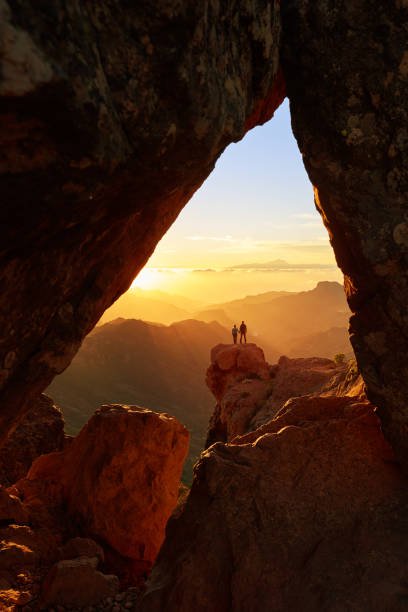
Best Places to Visit in Spain 2023
Spain, a country rich in history, culture, and breathtaking landscapes, beckons travelers with its vibrant cities, stunning beaches, and captivating architecture. From the enchanting streets of Barcelona to the sun-kissed shores of the Costa del Sol, Spain offers a diverse array of destinations to explore..

Europe: A Tapestry of Diversity, Culture and Adventure
Europe, a continent as diverse as it is beautiful, is a traveler’s dream come true. From the snow-capped peaks of the Alps to the sun-kissed beaches of the Mediterranean, Europe offers an enchanting mix of experiences for every type of traveler. Join us as we embark on a journey through the heart of Europe, discovering…

Our Top 5 Best Places to Visit in Kuwait
Discovering Kuwait: Journey Through its Hidden Treasures Hey fellow wanderlusters, let’s dive into Kuwait’s kaleidoscope of culture, where the past meets modernity. I’ve uncovered five must-visit spots for the young and adventurous traveler. From sipping on sweet tea under Bedouin tents to catching epic sunsets, Kuwait is an adventure waiting to happen. Map of Kuwait…

Our Top 5 Best Places to Visit in Dominica
Dominica: Where Adventure Meets Paradise Welcome to Dominica, the “Nature Island” of the Caribbean. If you’re seeking a destination that’s off the beaten path, brimming with natural wonders and adventure, you’ve found it. Here, you’ll explore lush rainforests, soak in rejuvenating hot springs, and dive into sparkling turquoise waters. Let’s embark on a journey to…
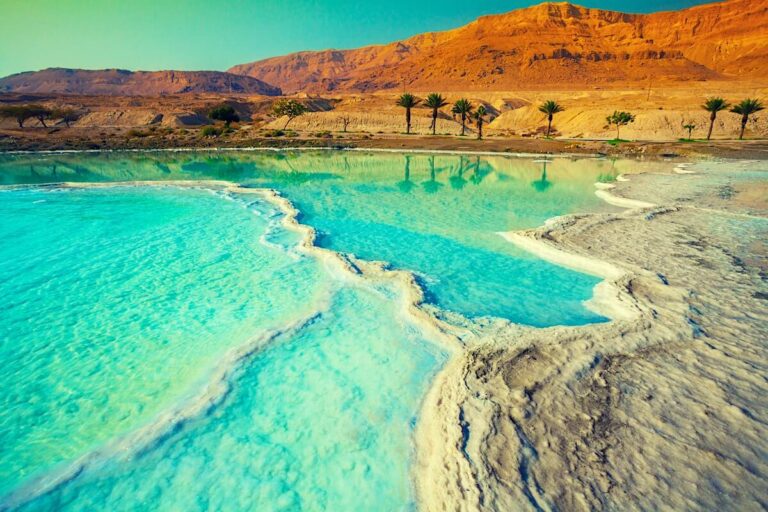
Our Top 5 Best Places to Visit in Jordan
My Journey Through Jordan’s Top 5 Destinations If you’re ready to dive into a world of ancient wonders, surreal landscapes, and incredible experiences, then Jordan is calling your name. Let me take you on a ride through my unforgettable journey as I uncovered the 5 best places to visit in this captivating country. Map of…

Our Top 5 Best Places to Visit in Lebanon
Lebanon Unveiled: Exploring the Mystique of the Middle East Welcome to the captivating land of Lebanon! Nestled along the Mediterranean Sea, this enchanting country is a treasure trove of history, culture, and natural beauty. Let’s embark on a journey to discover some of the most mesmerizing places that Lebanon has to offer. Map of Lebanon…
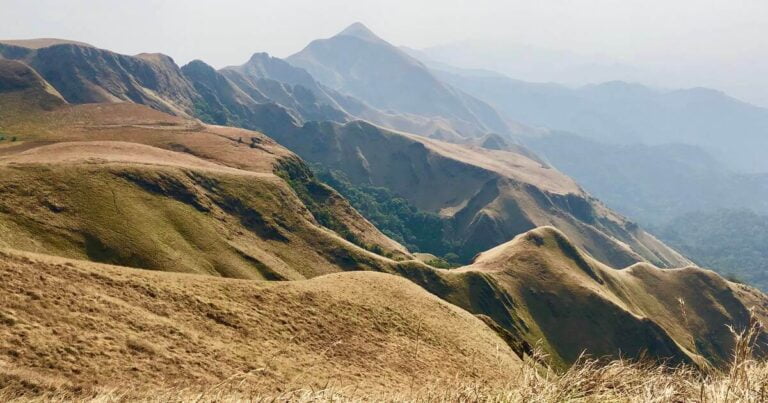
Our Top 5 Best Places to Visit in Guinea
Unveiling Guinea’s Hidden Treasures: 5 Must-Visit Places Are you ready for an off-the-beaten-path adventure in West Africa? Guinea, a hidden gem nestled between Guinea-Bissau, Senegal, Mali, Cote d’Ivoire, Liberia, and Sierra Leone, awaits your discovery. Prepare to be captivated by its vibrant culture, stunning landscapes, and welcoming people as we explore some of the must-visit…
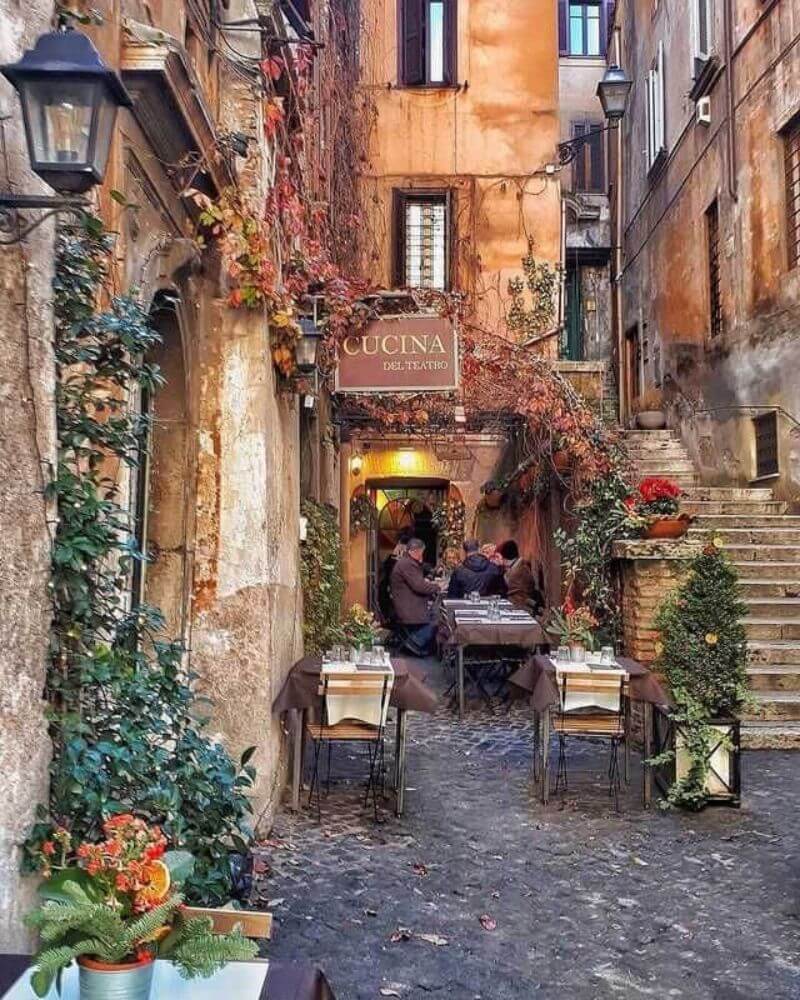
Best Places to Visit in Italy 2023
Italy, a land of romance, rich history, and breathtaking landscapes, beckons travelers with its magnetic allure. From the captivating cities adorned with timeless architecture to the picturesque coastal towns and rolling vineyards, this Mediterranean gem offers a plethora of unforgettable experiences..
Exploring Greece’s Timeless Treasures: Greece Best Places to Visit Top 10
Exploring Italy’s Treasures: The Best Places to Visit in Italy in 2023
Our 10 Best Places to Visit in Venice: Come Explore the Enchanting Floating City
Unveiling the Enchanting Beauty: Our Best Places to Visit in Florence
Our Best Free Places to Visit in New York That are yes, Absolutely FREE!
Our Best 10 Affordable Vacation Destinations if you are on a tight budget.
Our 10 Best Budget Travel Tips: Explore the World Without Draining Your Bank Account.
These are our Top 10 Best Travel Destinations Worldwide 2023
Our Absolute Best list of 10 Less Touristy Places to Travel in Europe 2023
Australia: A Traveler’s Paradise: Best Australian Destinations 2023
Our Top 5 Best Places To Visit In Kosovo – By David John
5 Best Places To Visit In Kosovo: Cover Image – Courtesy: wtg
Best Places To Visit In Kosovo: flickr images licensed under CC BY 2.0
Additional images: adobe · colourbox · istock · pexels · shutterstock · unsplash unless otherwise stated.
Were our Top 5 Best Places To Visit In Kosovo: helpful to you?
Let us know your thoughts in the comments below..
And if you are looking for a specific piece of information, please do comment below..
